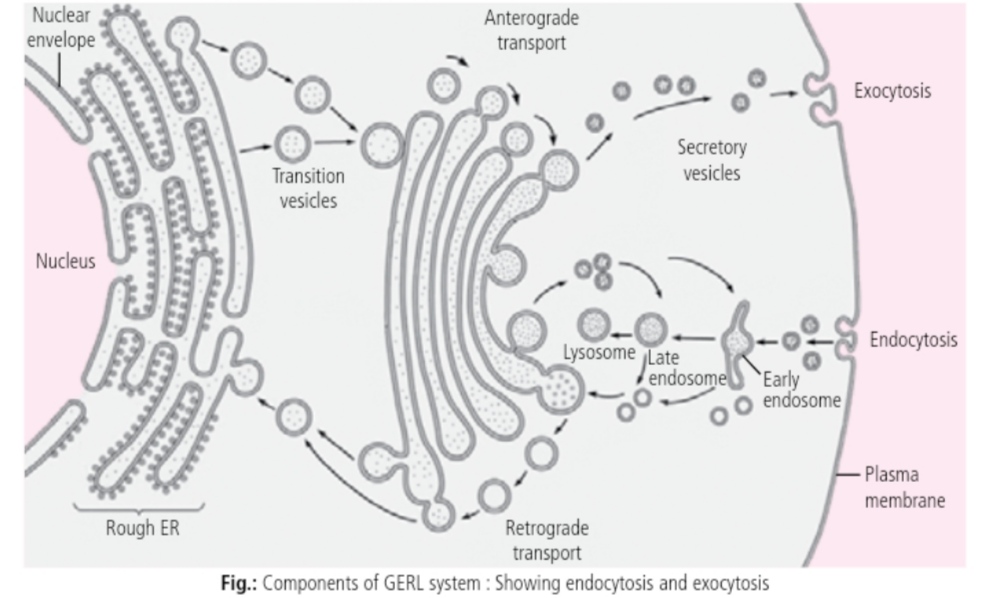The GERL system
The acronym GERL was discovered by Alex B Novikoff to come the idea that this set of structures constitutes a discrete system with distinctive cytochemical and morphological features and special functions GERL stands for Golgi - Endoplasmic Reticulum - Lysosomal complex
These three organelles form a system that combines with the endocytotic ( capturing a substance from outside the cell and exocytotic ( releasing substance outside the cell pathways to provide a means by which the cell.
1 ) Processes and packages secretory materials
2) Ingests or endocytoses external substances via phagocytosis and pinocytosis and excretes or exocytoses internal substances
( iii ) Performs many developmental processes involving shedding or remodeling of tissues , with removal of whole cells and extracellular material .
For example , the degeneration of the tadpole tail is caused by the action of cathepsins ( e . proteolytic enzymes ] contained in the lysosomes
COMPONENTS OF GERL SYSTEM
Golgi apparatus Golgi Apparatus ( Golgi complex )
Golgi complex was named after Camillo Golgi who recognised the organelle in nerve cells al barn owl in 1898 ) .
It is present in eukaryotic cells , except in mature sieve tubes of plants , mature RBCs of mammals , sperm cells of bryophytes and pteridophytes , etc It is absent in prokaryotic cells . In plants , it is called dictyosome ( cisternae not interconnected ) , it is surrounded by a zone of cytoplasm which is devoid of organelles . This one is called zone of exclusion.
Ultrastructure
Gold Golgi complex sa complex network of parallely arranged interconnecting system of smooth membranes having a central stack of flattened sacs called cisternae ( 0.5 um to 10 um diameter ) , tubules and vesicles .
It is present around or above the centrale in animal cells and scattered in cytoplasmic matrix in plant cells .
Each stack of cisternae , forming a dictyosome is a polarised structure having a proximal or forming face generally convex and closer to the nuclear envelope or the ER and a distal or maturing face of concave shape that encloses a region containing large secretory vesicles .
This polarisation is often referred to as the cis - trans ans of the Golgi complex .
Usually Golgi complex is made up of four parts :
Cisternae or saccules : These appear in the form of fiat , curved , smooth membraned structures with swollen ends . They have a definite polarity .
Their convex pole or proximal pole or els fact is associated with nuclear envelope .
The concave pole or distal pole or frans face , is the oldest , which gives rise to the secretory vesicles.
Tubules : These are smail , fat , interconnecting structures arising from the periphery of cisternae due to fenestrations of the cisterna .
Vesicles : These are targe rounded sacs 160 nm in diameter present at the edges of cisternae in dusters . These are pinched off from the tubules . These are of three types :
a) Transitional vesicles are small membrane limited vesicles which are thought to form as biebs from the transitional ER to migrate and converge to cis face of Golgi , where they coalesce to form new sterne
b ) Secretary vesicles are varied - sized membrane - limited vesicles which discharge from margins of cisternae of Golgi They often occur between the maturing face of Golgi and the plasma membrane
Clathrin - coated vesicles are spherical protuberances , about 50 um in diameter and with a rough surface . They are found at the periphery of the organelle , usually at the ends of single tubules , and are morphologically quite distinct from the secretory vesicles
( iv ) Golgian vacuoles : These are large , spherical vacuoles produced at maturing face . These are filled with some granular amorphous substances . Some of them function as lysosomes.
. • Snap Shots •
Golgi apparatus is present in all eukaryotic cells except sieve lubes of plants , sperms of bryophytes and pteridophytes and red blood corpuscles of mammals .
Cells that secrete many proteins such as salivary gland cells that secrete digestive enzymes , or cells of the immune system that secrete antibodies- have many Golgi stacks
• In plant cells , Golgi apparatus also makes polysaccharides , some of which are incorporated into the cell wall.













0 Comments